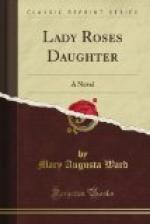“I make you angry,” she said, and her voice trembled, “without knowing how or why.”
Lady Henry gulped.
“Oh, it mayn’t answer,” she said, as their hands dropped. “But we may as well have one more trial. And, mademoiselle, I shall be delighted that you should assist the Duchess with her bazaar.”
Julie shook her head.
“I don’t think I have any heart for it,” she said, sadly; and then, as Lady Henry sat silent, she approached.
“You look very tired. Shall I send your maid?”
That melancholy and beautiful voice laid a strange spell on Lady Henry. Her companion appeared to her, for a moment, in a new light—as a personage of drama or romance. But she shook off the spell.
“At once, please. Another day like this would put an end to me.”
VII
Julie le Breton was sitting alone in her own small sitting-room. It was the morning of the Tuesday following her Sunday scene with Lady Henry, and she was busy with various household affairs. A small hamper of flowers, newly arrived from Lady Henry’s Surrey garden, and not yet unpacked, was standing open on the table, with various empty flower-glasses beside it. Julie was, at the moment, occupied with the “Stores order” for the month, and Lady Henry’s cook-housekeeper had but just left the room after delivering an urgent statement on the need for “relining” a large number of Lady Henry’s copper saucepans.
The room was plain and threadbare. It had been the school-room of various generations of Delafields in the past. But for an observant eye it contained a good many objects which threw light upon its present occupant’s character and history. In a small bookcase beside the fire were a number of volumes in French bindings. They represented either the French classics—Racine, Bossuet, Chateaubriand, Lamartine—which had formed the study of Julie’s convent days, or those other books—George Sand, Victor Hugo, Alfred de Musset, Mazzini, Leopardi, together with the poets and novelists of revolutionary Russia or Polish nationalism or Irish rebellion—which had been the favorite reading of both Lady Rose and her lover. They were but a hundred in all; but for Julie Le Breton they stood for the bridge by which, at will, memory and dreamful pity might carry her back into that vanished life she had once shared with her parents—those strange beings, so calm and yet so passionate in their beliefs, so wilful and yet so patient in their deeds, by whose acts her own experience was still wholly conditioned. In her little room there were no portraits of them visible. But on a side-table stood a small carved triptych. The oblong wings, which were open, contained photographs of figures from one of the great Bruges Memlings. The centre was covered by two wooden leaves delicately carved, and the leaves were locked. The inquisitive housemaid who dusted the room had once tried to open them.—in vain.




